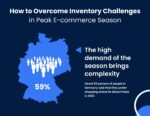Another day, another episode of the EGN podcast. This time our host Efe von Thenen talked with Fernando Veiga Fonseca, Global Domain Lead for Digital and Consumer at C&A. Our guest let us dive deep into C&A’s recent adoption of a headless commerce platform. But what does this term even mean? Don’t worry if you’re not familiar with it, we explain everything below!
Headless commerce refers to an architectural approach where the front end of an e-commerce platform is decoupled from its back end. This allows for greater flexibility and faster time-to-market. It enables companies to use the best solutions for different parts of the customer journey, such as acquisition, retention, order management, and payments.
Transitioning from Monolith to Headless
When Fernando Veiga Fonseca joined C&A, the project to transition to a headless commerce platform was already underway. The company was moving away from a centralized monolithic system, towards a more distributed and best-of-breed approach. This shift aimed to serve customers better with faster time-to-market and more tailored solutions.
The Benefits of Headless Commerce
During the interview our guest highlighted several benefits of adopting this new approach:
- Improved Performance: Decoupling the front end from the back end allows for better performance and faster order processing.
- Enhanced Flexibility: It enables quick adaptation to new markets, offering tailored solutions to different customer segments.
- Faster Time-to-Market: By using the best tools for each part of the customer journey, companies can bring changes to their products more quickly and efficiently
Common Pitfalls and Lessons Learned
No journey, however, is without challenges. Fernando shared with us some common pitfalls and lessons learned during the transition to headless commerce:
- Overly Sophisticated Setups: Implementing overly complex solutions can lead to unnecessary costs. It’s essential to align the sophistication of the setup with actual needs.
- Customization Issues: Extensive customization can hinder flexibility. It’s crucial to minimize customization and focus on leveraging existing solutions.
- Balancing Complexity and Flexibility: Companies need to find the right balance between complexity and flexibility based on their size and consumer needs.
Want to find out more about headless commerce including our guest’s advice for small businesses in relation to this topic? Watch the full talk here:
Can’t watch? No problem. It is also available on Spotify and Apple Podcast.
***





![Expert Insights on How to Improve Consumer Trust [The PwC Report]](https://ecommercegermany.com/wp-content/uploads/2024/06/pexels-olly-920382-150x100.jpg)